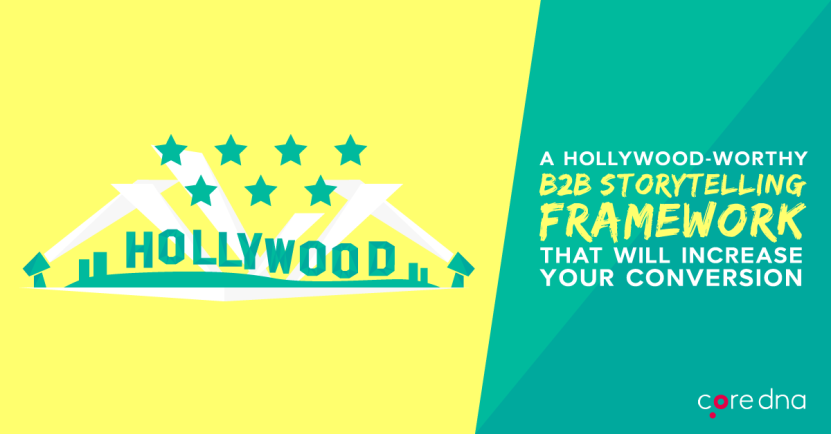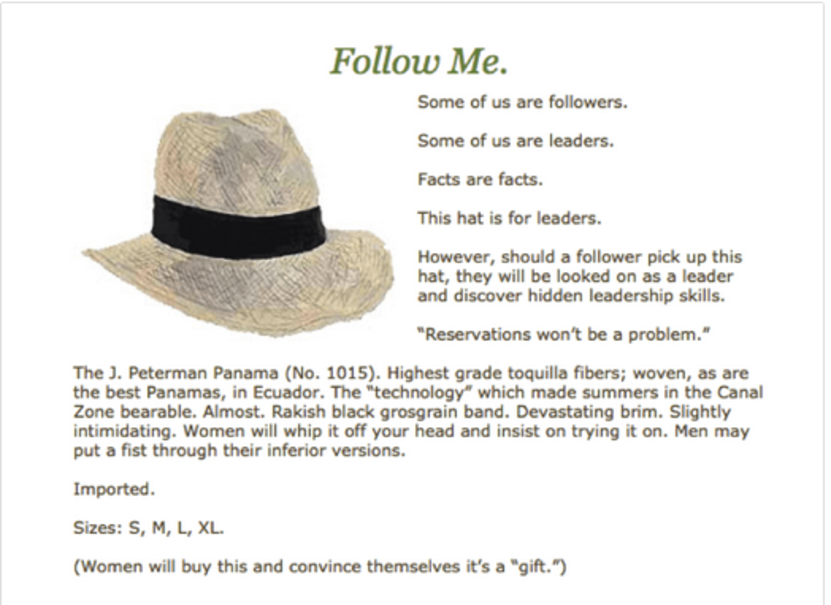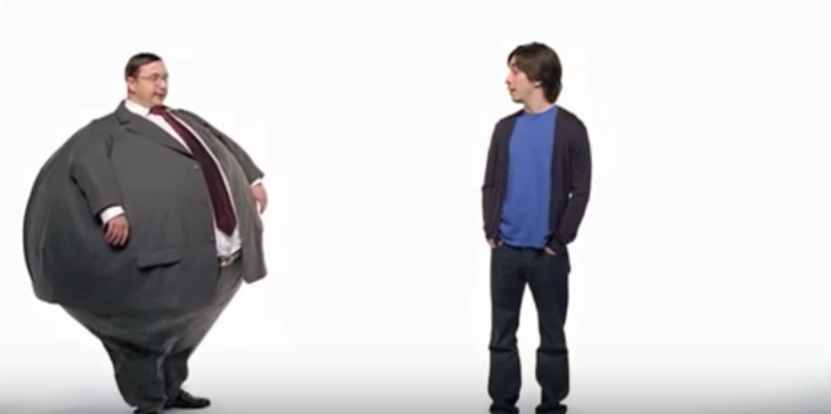A Hollywood-Worthy B2B Storytelling Framework That Will Increase Your Conversion

Ever realize how preachers (and teachers) always use stories to make a point?
There’s a reason for that: infused with lessons and sermons, stories command greater attention, are easier to digest, and are inherently better at “sticking in your brain”.
Numerous studies have shown that stories aren’t only more effective in making a message memorable, they’re also more emotionally provocative. Pair this with research that shows we make decisions primarily with emotion (using logic to justify them later), and you have the power of story in a nutshell (thanks Nichole Elizabeth DeMeré).
But there’s a fine line between b2b storytelling that successfully creates a buzz around your brand and content, and a boring brand backstory that pulls customers to sleep - killing any kind of buzz.
So if you’re looking to harness the power of storytelling in your content marketing, keep reading…
On this page:
The shocking impact stories has on your brain
If you’ve ever bought something from a store and wondered “Why on earth did I buy this?”, you’re not alone. Research shows that emotions greatly influence buying behavior:
- Neuro-imagery shows that consumers base buying decisions on personal feelings and experiences rather than the features, facts, and attributes of a brand.
- The emotional response to an ad is far more influential on a consumer’s intent to buy than the content of the ad itself.
- The more likable an ad is, the more it will increase a brand’s sales.
And when it comes to likeability and arousing emotions, storytelling reigns supreme.
“Storytelling is like a vitamin. When it gets into your readers, it permeates their whole being, and fights every objection that might otherwise stop them from becoming loyal customers.” - Neil Patel
When Italian neuro-psychologists were studying the motor neuron activities of Macaque Monkeys, they made a shocking discovery.
While watching a researcher reach for food, the area of a monkey’s brain that would normally react to reaching for food had fired up. But physically, the monkey wasn’t doing anything. It was just watching.
This is because we feel other people’s thoughts and actions through mirror neurons.
Neuroeconomist Paul Zak‘s research shows that our brains produce the stress hormone cortisol during tense moments of a story, allowing us to focus; while the cute factor of animals/babies releases oxytocin, the “feel-good” chemical that drives connection and empathy.
In one experiment people watched an emotionally charged movie about a father and son. Zak then asked them to donate money to a stranger. And guess what?
Subjects who had higher amounts of oxytocin were much more likely to give money to a random stranger.
How storytelling helped sell $300 dollar items for $3000
Journalist Rob Walker conducted an experiment to test the emotional power that stories have on our perceived value of products.
He hired a group of writers to create emotionally charged stories about unwanted, junk items from thrift stores. The items were then listed on eBay, each with its own story.
The results of this experiment?
$128 worth of junk thrift store items sold for a whopping $3,612.51. An overall value increase of over 2,700%.
Yup, thanks to the huge emotional punch that stories pack, literal junk was sold at insane prices.
2 solid examples Of brand storytelling
To see the impact that stories can make on buying decisions, take a look at online clothing store J.peterman. They have a firm grasp on potent stories that sell:

They could have easily just said “This hat will arouse the envy of other men. The interest of women. And respect from strangers.” But they didn’t.
Instead, their description tells a vivid story of who the reader becomes when wearing the hat. It triggers thoughts of sudden conversations, envious eyebrow raises, curious glances from women, and friendly nods of approval from strangers.
It uses story to create a greed-gland-pumping mental experience.
Another great storytelling example comes from Cisco. Specifically, their collaboration video that targets entertainment/marketing-based businesses.

There’s no cheesy professional advert telling you how awesome their software is. Instead, you’re drawn into the busy schedule of a PR company competing for the business of a popular DJ.
And if you look carefully, there are some smart storytelling fundamentals buried in the video.
Cisco does a great job of creating a strong setting that relates to customers. Our characters are under high pressure and are having to constantly adapt. Cisco then follows up with constant tension; the company secures the deal, but the DJ wants to come early, then he decided to not come at all etc.
Finally, you get the happy ending. Thanks to Cisco’s tech, they’re able to communicate with him and get the ball rolling. It’s simple, memorable, storytelling that works.
But what does “Telling your story” actually mean?
You know how powerful storytelling is. You’re aware of its persuasive prowess and ability to connect with customers. But, it’s not like there’s a magic on-and-off button that activates storytelling in your business. So how do you go about effectively telling persuasive stories that sell?
First off, storytelling doesn’t mean your story.
It’s not about your product or your company. If that was the case, every company would have amazing stories on their about page. Storytelling doesn’t have to be long winded and complicated. Yes, a little imagination is needed, but it can be fairly simple.
Here are some quick hacks to get you started in the right direction:
B2B storytelling tip #1: Be ultra-specific
You know those common claims that have struck everyone's eardrums one too many times?
- “Greater cleaning efficiency”
- “A new revolutionary breakthrough”
- “Next-gen technology”
The problem is, when everyone out there is supposedly “super”, “revolutionary” and “exclusive”... then no one is. Boastful buzzwords have saturated advertising and people have become numb to them. And thanks to their overuse, they’re as effective as a potato peeler in a gunfight.
So it’s best to stay away from them.
And if you really want to emphasize a unique attribute about your company, tell ultra-specific stories. Instead of making cliched claims, show how you’re “the most advanced” or “highest quality” with specific details.
In the early 1900’s, Claude Hopkins catapulted Schlitz beer from ranking no.8th in sales to no.1.
At the time, all beer companies made boastful claims about how pure their beers were. Every single one of them. But, in the ad that took Schlitz to the top, Hopkins specifically described how they purified their beer.
The ad described how the beer was cooled in a special way that removed impurities. How magnificent the expensive white pulp filters were. How every pipe was cleaned twice for purity, and how each bottle was sterilized four times before it was trusted to hold the pure Schlitz beer.
Compare that descriptive story with the simple statement every other company made:
“Our beer is pure”.
You’re guaranteed to have more trust in the schlitz ad, right? That’s the power of a specific story
B2B storytelling tip #2: Pick a fight with a company, idea, or image
A controversial study noted the psychology of people when engaged in acts of mass hatred. It had some interesting finds…
The study revealed that, even with the smallest of distinctions, it was possible to create groups of people who would show loyalty to their own group while fully discriminating against others.
In the tests, people were asked to choose between two people or objects they had no previous connection to. Later on, when asked to dole out rewards to their chosen people or objects, subjects showed a huge bias towards their “in-group” and were less likely to share rewards with “outsiders”.
Sounds a little extreme, right?
Well, your favorite brands have used this technique to weave a story that repels them from the competition and pulls you over to their side. In their MAC vs PC beef, Apple knuckled up against the PC to strengthen their brand image.

(Apple pulls no punches in these ads)
By attacking the PC, Apple tells a relatable story that says: “The MAC is for cool, creative and innovative people. While the PC is for boring corporate drones who use their archaic technology to create ho-hum spreadsheets and wearisome word docs.”
Now, do you have to single someone out for a marketing brawl?
Nope. You can use an idea or common concept as your common enemy. Just like Ashley Ambirge (Ash) did with her The Middle Finger Project:

The email opt-in reads: “For people with a f**king sense of humor.” And it quickly shows that they’re raising the sword against boring, humdrum business culture. It also strongly suggests they are a fun, unorthodox company to work with.
B2B storytelling tip #3: Highlight your customer’s story
TV shows often use a laugh track when a punchline is delivered. And even though the audience knows it’s a recording...it doesn’t stop them from laughing along with it.
Street performers may chuck a few $5 bills into their jar instead of 50 cents or $1 tips...this shows that $5 is what everyone else is giving. Which ideally increases the chance of others donating $5 bills.
Telling your customer’s story is a compelling form of social proof. And social proof persuades us because:
- We are naturally skeptical
- We care greatly about what others think of us
- And we’re more likely to do something if “everyone else is doing it”
People might be skeptical about what you say about your product, but they’re likely to believe what someone else who’s used your product has said. That’s why case studies, testimonials, and reviews are great for squeezing more story into your selling.
B2B storytelling tip #4: Be on a mission
No, not a fake “we care about the environment too” mission. A real mission. One that your business actively pursues in its everyday activity. Being on a mission elevates you above the noise. It prevents you from being just another brand on the block and subtly tells customers your story by explaining what you strive for.
Just take a look at Patagonia’s mission statement:

Without them saying much, you envision a sincere company on a movement to do good business and make the world a better place. It’s an overall solid introduction to the company.
“How do you make a corporation empathetic? People have antipathy toward corporations. This is one of the reasons why so many companies like Starbucks, like Tide, have missions. You can tell the story about a mission—about what Tide is doing for people living in disaster areas, what Starbucks is doing to help educate its employees—you can dramatize it. The corporation comes alive, has a heart, and is out there on a mission.” - Robert McKee (via Skyword)
The step-by-step B2B storytelling recipe
Analyzing every angle of your brand to come up with a compelling story can be a nightmare. Sure, you could lock yourself in the office with thousands of customer personas and mission statements, waiting for that sweet but fleeting story idea to smack you on the head.
Or, you could follow a raw recipe that harnesses the power of storytelling for your own brand…
One that’s based on the science behind crafting compelling stories - and shares DNA with stories that make you cry, laugh, and sometimes, scared to crawl out of bed. What follows is a short and simple recipe for cooking up your own unique brand story that will connect with customers.
Let’s get started.
The basics of plot and story
Ever read a book that sunk its teeth into your brain, never letting go until the last page?
Tere’s a lot in common between a riveting read and a blockbuster brand story. Knowing these common concrete basics of plot and story will enable you to craft stronger messages that penetrate your customer’s heart and brain.
Below are some quick, essential components for constructing memorable stories.
Tension is key
Without tension, you don't have a story. You just have a boring sequence of events:
Boy meets girl. Boy asks girl to marry him, and girl says “yes”.
Yawn! See how boring this is?
Tension stems from thwarting progress - this is where the driving pain or problem arises:
Boy meets girl. Boy asks girl to marry him, girl says “no”. Why not cries boy. “Because you’re a drunkard”, says girl.
Not quite Twilight level yet, but it is better than the initial boring narration.
The solution/result
Where an answer to the problem starts forming. A guide, a tool, or an insight into what needs to be done appears:
Boy struggles with his habit. Stumbling from bar to bar, burying the pain that forces him to drink. Committed to marrying the girl, he finds a mentor in an AA meeting who is 10 years sober.
The transformation
During the story, the character should undergo some form of change. For better or worse, it doesn’t matter. But the transformation does. Otherwise, you have a static character, which makes for a bone-dry story.
3 years later boy conquers his habit and is married to girl, finally a man. He finds fulfillment in teaching others how to conquer their drinking urges and dedicates his life to it.
Now you have a story that has a beating pulse. It feels more real and satisfying. Which makes it more likely to draw your customers sympathy and attention.
You’ve got a grasp on the basics of a story, let’s now look at how to piece those blocks together to craft an effective story for a B2B product or service …
1. Who is your best character?
Every story starts with a character & your prospect needs to be able to identify themselves in that character. So before you get to the meaty and potatoes, decide on the following:
- Who is your character?
- What do they do?
- What industry are they in?
- What’s the problem they’re facing?
Think carefully about who you’re choosing to be the initial touchpoint of your story.
This will be the “character” that all your prospective customers will be experiencing the story through. It has to be a character the rest of your potential customers can relate to, like, and sympathize with.
Quick tip: To get a fix on who your character should be, have a look at your customer personas. Ask yourself:
- Which segment is the most similar to potential customers?
- Which segment is the most relatable?
Answering those two questions will give you solid ground to start on.
2. Expose your character's pain/desire
This is where tension propels your story forward. Something disrupts your character's world and forces them into action.
For example, in the movie Taken, the protagonist’s daughter is kidnapped, in Spiderman, Mary jane and the city of New York is in danger; and in this Cisco ad, the company is competing for the attention of an important artist.
You may have briefly showed your characters burning pain/desire at the start. But that’s not enough. Your story has to arouse sympathy and relate to your potential customers. Which means, you need to give an accurate depiction of his problem and the trouble/pain it is causing.
3. Finally, introduce the game-changing solution
This case study on the Sunshine Aquarium does a great job of introducing an awesome solution.
The aquarium’s foot traffic was taking a nosedive. Potential customers were being tempted by Tokyo’s immense distractions. To prevent themselves from drowning among the noise, they needed to cut through the clutter and “peacock” their business.
When you consider that it’s a 35-year-old aquarium in a densely populated city rammed with distractions, you can grasp what a big task this was...
Their solution?
Use people’s natural attraction to cute animals to overpower distractions and guide them - with street smart augmented reality penguin escorts...
Once near the aquarium, customers would download an app and follow a cute group of on-screen penguins to find their way.
This augmented reality escapade transformed boring point-to-point travel into an enjoyable adventure which initially boosted foot traffic by 152% (and still reels in business); despite no change in the exhibition content.
The video tells a fun story about how AR is a game-changer for improving business. Our main character (sunshine aquarium) is struggling with getting foot traffic in the bustling city (the source of tension). We’re then shown how augmented reality (the game-changer) solved this problem.
But showing your product/service as a game-changing solution isn’t enough. Why? Because it doesn’t complete the story. Remember, there has to be some sort of transformation.
So, conclude by showing how the results changed your customer’s business/life.













